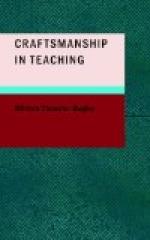These are problems, I repeat, that stand to the chief problem as means stand to end. Now some of these questions must be solved by every teacher for himself, but that does not prevent each teacher from solving them scientifically. Others, it is clear, might be solved once and for all by the right kind of an investigation,—might result in permanent and universal laws which any one could apply.
There are, of course, several ways in which answers for these questions may be secured. One way is that of a priori reasoning,—the deductive procedure. This method may be thoroughly scientific, depending of course upon the validity of our general principles as applied to the specific problem. Ordinarily this validity can be determined only by trial; consequently these a priori inferences should be looked upon as hypotheses to be tested by trial under standard conditions. For example, I might argue that The Tale of Two Cities should be placed in the third year because the emotional ferment of adolescence is then most favorable for the engendering of the ideal. But in the first place, this assumed principle would itself be subject to grave question and it would also have to be determined whether there is so little variation among the pupils in respect of physiological age as to permit the application to all of a generalization that might conceivably apply only to the average child. In other words, all of our generalizations applying to average pupils must be applied with a knowledge of the extent and range of variation from the average. Some people say that there is no such thing as an average child, but, for all practical purposes, the average child is a very real reality,—he is, in fact, more numerous than any other single class; but this does not mean that there may be not enough variations from the average to make unwise the application of our principle.
I refer to this hypothetical case to show the extreme difficulty of reaching anything more than hypotheses by a priori reasoning. We have a certain number of fairly well established general principles in secondary education. Perhaps those most frequently employed are our generalizations regarding adolescence and its influences upon the mental and especially the emotional life of high-school pupils. Stanley Hall’s work in this field is wonderfully stimulating and suggestive, and yet we should not forget that most of his generalizations are, after all, only plausible hypotheses to be acted upon as tentative guides for practice and to be tested carefully under controlled conditions, rather than to be accepted as immutable and unchangeable laws. We sometimes assume that all high-school pupils are adolescents, when the likelihood is that an appreciable proportion of pupils in the first two years have not yet reached this important node of their development.




